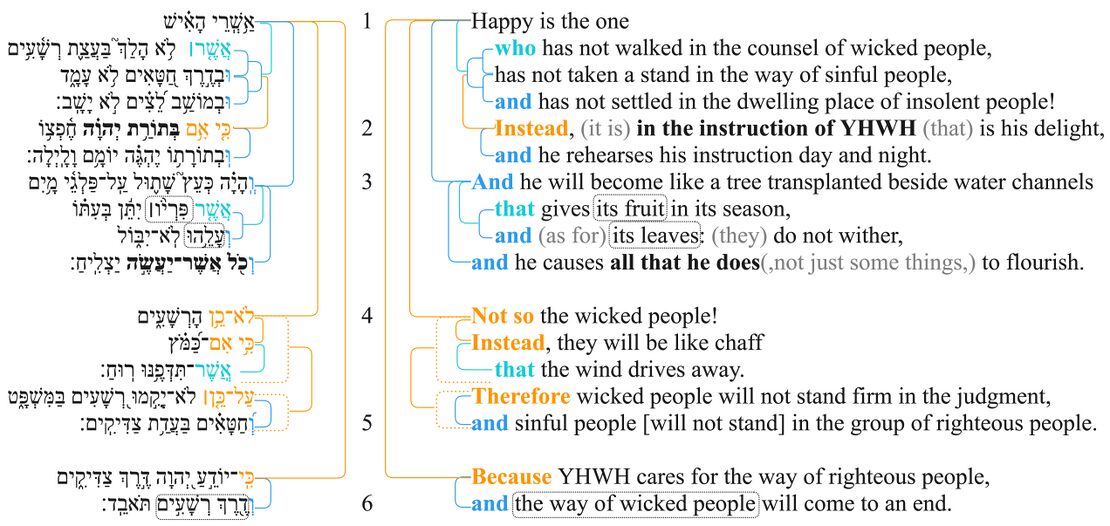Psalm 1 Macrosyntax
From Psalms: Layer by Layer
Psalm 1/Macrosyntax
Choose a PsalmNavigate Psalm 1
Macrosyntax
Macrosyntax Diagram
| Macrosyntax legend | |
|---|---|
| Vocatives | Vocatives are indicated by purple text. |
| Discourse marker | Discourse markers (such as כִּי, הִנֵּה, לָכֵן) are indicated by orange text. |
| The scope governed by the discourse marker is indicated by a dashed orange bracket connecting the discourse marker to its scope. | |
| The preceding discourse grounding the discourse marker is indicated by a solid orange bracket encompassing the relevant clauses. | |
| Subordinating conjunction | The subordinating conjunction is indicated by teal text. |
| Subordination is indicated by a solid teal bracket connecting the subordinating conjunction with the clause to which it is subordinate. | |
| Coordinating conjunction | The coordinating conjunction is indicated by blue text. |
| Coordination is indicated by a solid blue line connecting the coordinating clauses. | |
| Coordination without an explicit conjunction is indicated by a dashed blue line connecting the coordinated clauses. | |
| Marked topic is indicated by a black dashed rounded rectangle around the marked words. | |
| The scope of the activated topic is indicated by a black dashed bracket encompassing the relevant clauses. | |
| Marked focus or thetic sentence | Marked focus (if one constituent) or thetic sentences[1] are indicated by bold text. |
| Frame setters[2] are indicated by a solid gray rounded rectangle around the marked words. | |
| [blank line] | Discourse discontinuity is indicated by a blank line. |
| [indentation] | Syntactic subordination is indicated by indentation. |
| Direct speech is indicated by a solid black rectangle surrounding all relevant clauses. | |
| (text to elucidate the meaning of the macrosyntactic structures) | Within the CBC, any text elucidating the meaning of macrosyntax is indicated in gray text inside parentheses. |
If an emendation or revocalization is preferred, that emendation or revocalization will be marked in the Hebrew text of all the visuals.
| Emendations/Revocalizations legend | |
|---|---|
| *Emended text* | Emended text, text in which the consonants differ from the consonants of the Masoretic text, is indicated by blue asterisks on either side of the emendation. |
| *Revocalized text* | Revocalized text, text in which only the vowels differ from the vowels of the Masoretic text, is indicated by purple asterisks on either side of the revocalization. |
(Click diagram to enlarge)
- vv. 1-3. The discourse topic of vv. 1-3 is "the one" (הָאִישׁ), introduced with the definite article. The opening line of this paragraph is a sentence fragment.
- vv. 4-5. The discourse topic of vv. 4-5 is "the wicked" (הָרְשָׁעִים), also introduced with the definite article. The opening line of this paragraph is also a sentence fragment.
- v. 6. This last verse, which grounds the entire discourse (see above), is about both the righteous (v. 6a, cf. vv. 1-3) and the wicked (v. 6b, cf. vv. 4-5).
- The discourse markers (discussed above) further support these paragraph divisions. (See further poetic structure).
- See Lunn 2006, 195-200 for a detailed discussion of the word order in this psalm.
- v. 1bc. The prepositional phrase "in the way of sinful people" is fronted to create a symmetric poetic structure with 1aβ. This same pattern (fronted prepositional phrase) is then repeated in v. 1c.
- v. 2a. The prepositional phrase "in YHWH's instruction" is "an instance of replacing focus... Fronting invariably takes place in the clause containing the information replacing that of the negated first clause"[3]: not this, but that.
- v. 2b. The prepositional phrase "in his instruction" is fronted to create a poetic repetition of v. 2a.
- v. 3bc. The initial description of the tree is followed by two relative clauses (v. 3bc) further describing the parts of the tree: "its fruit...its leaves." Each of these relative clauses introduces the parts of the tree with a topic-fronted noun phrase.
- 'v. 3d. "The joining of the quantifier to the... object... serves to highlight the degree of extent of the entity in question. Here the stress is on the 'everything', Everything he does prospers', not just some things."[4] The predication "cause to flourish" is accessible in the context, since "flourishing" is associated with both pathways (v. 1, cf. Josh 1:8) and plants (v. 3, cf. Ezek 17:9).
- v. 6b. The subject "way of wicked people" is fronted for contrastive topic. "What we have in this verse... is that which has been traditionally designated antithetical parallelism, but which in the context of this study has been redefined in terms of a marked contrastive construction."[5]
There are no notes on vocatives for this psalm.
- v. 2. The discourse marker "instead" (כִּי אִם) marks a contrast between what the person does not do (v. 1) and what he does do (v. 2)—"not... in (ב) the counsel of the wicked... Instead... in (ב) YHWH's instruction. Moreover, "with כִּי אִם the speaker makes it very clear that not only is an alternative involved, but that it is the only possible alternative" (BHRG §40.29.2). In other words, either one follows the counsel of wicked people (v. 1) or one follows the instruction of YHWH (v. 2); there is no middle ground.
- v. 3. The waw in v. 3 (וְהָיָה) binds v. 3 to vv. 1-2, as part of the celebration (אַשְׁרֵי, v. 1) of the person.
- v. 4. The discourse marker "not so" (לֹא־כֵן) draws a contrast between "the wicked" (v. 4) and "the one" (vv. 1-3). Because v. 4 goes on to say that the wicked are "instead... like chaff" (v. 4b), the contrast is, most immediately, between v. 4 ("like chaff") and v. 3 ("like a tree"). But given the fact that v. 3 is bound to vv. 1-2 and v. 4a echoes v. 1a (see poetic structure), we are probably to understand the contrast ("not so" לֹא־כֵן) as extending all the way back to v. 1. Unlike the righteous person, the wicked do not reject evil (v. 1), rehearse YHWH's instruction (v. 2) and flourish like trees (v. 3), and so that are not to be celebrated (v. 1a).
- v. 4b. The discourse marker "instead" (cf. v. 2) marks a contrast with the previous line: "The wicked are not like the person just described. Instead, they are like chaff..."
- v. 5. The discourse marker "Therefore" (עַל־כֵּן) introducing v. 5 marks a logical conclusion based on something in the previous discourse. It makes the most sense that the conclusion is based on v. 4: "Because the wicked are like chaff that the wind blows away, they will not stand firm in the judgment." (Judgment is likened to a winnowing process, in which the 'chaff' (=the wicked) and the grain (=the righteous) are separated. See Story Behind).
- v. 6. The discourse marker "Because" (כִּי) in v. 6 grounds the entire discourse (so BHRG §40.29.2). It explains, in summary, why the righteous (and not the wicked) are to be considered "happy." It is a common pattern in the Psalter for the final verse to begin with כִּי and function as a summary of the whole (see e.g., Pss 5, 11, 134).
There are no notes on conjunctions for this psalm.
- ↑ When the entire utterance is new/unexpected, it is a thetic sentence (often called "sentence focus"). See our Creator Guidelines for more information on topic and focus.
- ↑ Frame setters are any orientational constituent – typically, but not limited to, spatio-temporal adverbials – function to "limit the applicability of the main predication to a certain restricted domain" and "indicate the general type of information that can be given" in the clause nucleus (Krifka & Musan 2012: 31-32). In previous scholarship, they have been referred to as contextualizing constituents (see, e.g., Buth (1994), “Contextualizing Constituents as Topic, Non-Sequential Background and Dramatic Pause: Hebrew and Aramaic evidence,” in E. Engberg-Pedersen, L. Falster Jakobsen and L. Schack Rasmussen (eds.) Function and expression in Functional Grammar. Berlin: Mouton de Gruyter, 215-231; Buth (2023), “Functional Grammar and the Pragmatics of Information Structure for Biblical Languages,” in W. A. Ross & E. Robar (eds.) Linguistic Theory and the Biblical Text. Cambridge: Open Book Publishers, 67-116), but this has been conflated with the function of topic. In brief: sentence topics, belonging to the clause nucleus, are the entity or event about which the clause provides a new predication; frame setters do not belong in the clause nucleus and rather provide a contextual orientation by which to understand the following clause.
- ↑ Lunn 2006, 197.
- ↑ Lunn 2006, 198-9; cf. Eccl. 8:3; Prov 17:8.
- ↑ Lunn 2006, 200.


